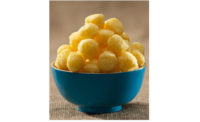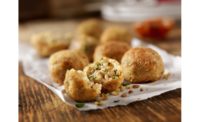Laurie Scanlin, Ph.D.
Crackers—the thin, crispy, savory biscuits enjoyed by Americans for hundreds of years—have come a long way. They are no longer made with just one primary ingredient, such as a wheat, rice or nut flour. Today, they are made with a combination of flours and grains, which answers a growing consumer demand for more plant-based and plant-forward foods.
These days, innovation in crackers comes in many forms. It is largely driven by demand in the marketplace for plant-based ingredients, such as chickpea, quinoa, chia, flax and vegetables like beets, kale, mushrooms and sweet potatoes.
Beyond just diversifying nutritional ingredients in the traditional cracker, the inclusion of these grains adds texture, color and visibility. Grain crisps, such as quinoa, sorghum and whole-grain brown rice, offer nutrition, crunchy or delicate textures, varied color and visual appeal.
Mintel’s February 2019 “U.S. Crackers Market Report” notes that cracker sales in the U.S. have been relatively flat over the past five years and low growth is anticipated for the next five years. However, innovation will be the key to meet the needs of the 90 percent of American consumers who eat crackers regularly and speed overall growth in the sector.
In response to consumer demand for quality ingredients and transparency, brands are launching products with modern takes on classic items. They are connecting with consumers around modern lifestyles for grab-and-go nutrition, social enjoyment, environmental responsibility, form and function.
 Better health has been a trend for years, even in snacking. Healthy fats (both mono and unsaturated) are on trend, including avocado and coconut…even certain types of butter.
Better health has been a trend for years, even in snacking. Healthy fats (both mono and unsaturated) are on trend, including avocado and coconut…even certain types of butter.
The current focus on the connection between microbiome and gut health and overall health will continue to grow and will be reflected in new products, as well. Prebiotic fibers, such as beta-glucan from barley and oats, are nutrients that feed probiotics and can be formulated into crackers and crisps.
My colleague, Joel Thompson, corporate R&D chef at Ardent Mills, sees crackers as “super-ripe for flavor innovation,” with more opportunity to develop crackers for personalized health. For instance, parents are looking for healthy snacks, so sweet, naturally fruit-flavored and colored crackers are appealing. People who love cheese plates that contain dried nuts, fresh fruit and artisan cheese would welcome more sophisticated crackers with ingredients like rosemary, gorgonzola, goat cheese and other upscale combinations. Grains could be matched to cheese and dried fruits based on flavor profiles; for example, sorghum has a brown-rice flavor, amaranth is nutty and earthy, and quinoa, when crisped, has a peanut-buttery taste.
Many crackers on the market are branded as “thins” and “crisps” today, and presentation is important. These days, more consumers are attracted to natural and rustic-looking crackers with “rough” edges and visible grain ingredients. They are interested in high-quality ingredients and transparency, and they want to know what they’re eating and feeding their families.
Thanks to the increasing interest in understanding where food is sourced, stories about farmers will likely make their way into the packaged-snack aisles. There is also room for crossover innovation with other categories, such as rye, spelt and sourdough breads.
Mintel reports that crackers straddle indulgent and healthy categories, which makes packaging descriptions, pairing suggestions and usage ideas important for increasing consumer understanding and reinvigorating this mature category. Cracker innovation is expected to continue to meet consumer needs for nutrition, transparency, convenience and foodie-inspired flavors. We will start seeing this across retail platforms, including automated convenience stores catering to real consumer needs like saving time, personalization and convenience.
Laurie Scanlin, Ph.D., is R&D Culinary Manager, RQT, at Ardent Mills in Denver.
For more insight into current cracker trends, see “Creative crackers stand out in a stable snack market.”







